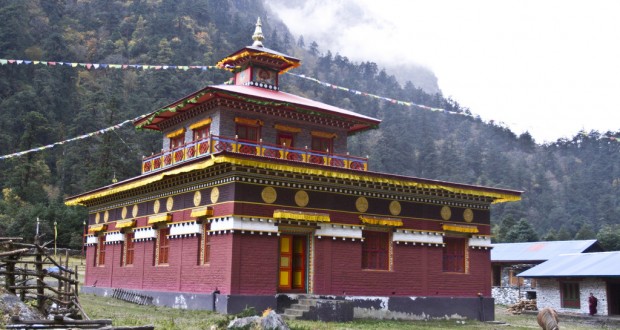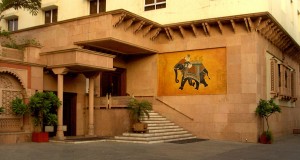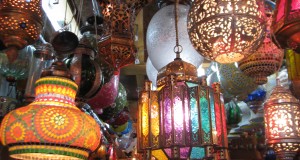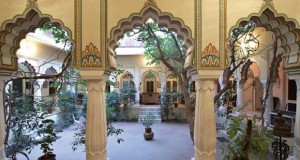Review Overview
2
Summary : Hemis is a great place to stay over—either in the monastery or at the newly built guesthouse.
Shey-Thikse-Hemis
This is the most popular gompas circuit. If travelling by jeep, set out early morning, see the monasteries in the order given, and expect to be back by lunch. Alternatively, catch the first bus out to Shey (for 7.30 am prayers), proceed straight on to Hemis (bus stops here for 2/3 hours sightseeing), and backtrack to Thikse. This way, you can easily be back in Leh by sunset. Even if going by jeep, take a packed lunch from your hotel and have the flexibility to spend the whole day out.
Driving out to Shey, the road is lined with rnani walls (carved with the Tibetan Buddhist mantra ‘Om Mani Padme Hum’, or Hail to the Jewel in the Lotus) and conical stupas called chortens (symbolising the mind of the 13 rings representing the 13 realms of human consciousness). Like the gompas or monasteries, these shortens are made of unbaked earth or clay, and appear to be a natural extension of the surrounding desert. Some 14 km (83/4 miles) upstream from Leh, you’ll come to Shey, a 15th-century palace gornpa built by Lhachen Palgyigon, the first king of Ladakh. The old summer palace of the royal family, it houses in a back chamber of the gornpa the largest golden Buddha in Ladak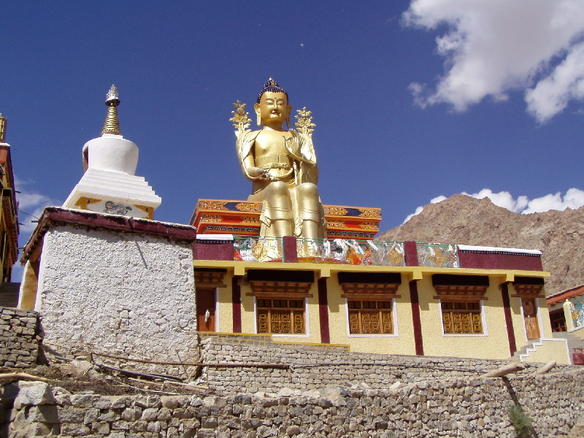 h, 7.5 m (22 ft) high. Making three anti-clockwise circuits of the image cleanses you of past sins, and solicitous signs outside prevent you committing any new ones. Views over the Indus plain from the palace roof are superb. The gompa is open from 7 to 9 am, and from 5 to 6 pm. At other times, you may have to walk over to Sabu, the nearby village, to ask Shey’s only monk for the key. Sabu is also the favourite home of Shey’s famous oracle.
h, 7.5 m (22 ft) high. Making three anti-clockwise circuits of the image cleanses you of past sins, and solicitous signs outside prevent you committing any new ones. Views over the Indus plain from the palace roof are superb. The gompa is open from 7 to 9 am, and from 5 to 6 pm. At other times, you may have to walk over to Sabu, the nearby village, to ask Shey’s only monk for the key. Sabu is also the favourite home of Shey’s famous oracle.
From Shey, it’s only 3 km (2 miles) down the road to Thikse Gompa. This is a spectacular 10-storey congregation of buildings perched atop a rocky crag. Built some 500 years ago, Thikse has the largest number of lamas and nuns of any gornpa, houses the greatest collection of ancient Buddhist scriptures and books in Ladakh, and is a masterpiece of construction. The lower eight monasteries are heaped one on top of the other in perfect symmetry, their blank slit windows staring across the plain like empty eyes. The top two levels, which house the head lama, are painted in gay colours. It’s a stiff climb up there, but you get an enthusiastic welcome and you can ‘enjoy cold drink and postcard’ at the small refreshment shop. The views from the upper levels are amazing. Just beyond the temple courtyard, a seated Buddha surveys the largest library in Ladakh. In the rooms behind, there’s an intricately carved statue of the ‘white Tara’ (a female Buddhist deity) and a painting of Yamaraja (the Hindu god of death), both showing the early influence of Hinduism over the religion of these hills. 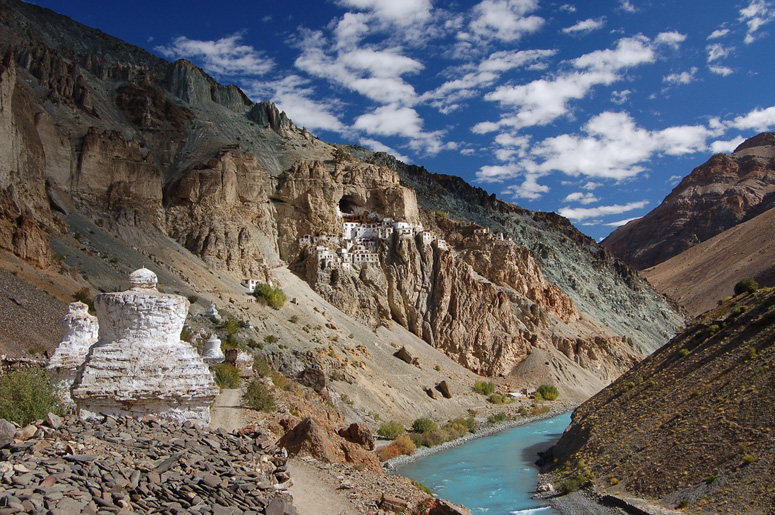
But Thikse’s most striking structure, three floors further up, is the 15-m high, heavily bejewelled, and colourfully adorned statue of Maitreys Buddha, the eighth incarnation of Buddha anxiously awaited by Tibetan Buddhist . Behind this, in a small back-annexe, a line of dusty old Buddhas gaze astonished at weird tantric wall-paintings—mainly of chickens flying off with antelope livers. This is a hotel-restaurant at Thikse, and if you get up at 6.30 am you will witness two monks blowing conch shells on the roof, followed by 7 am prayers. Staying overnight, you’ll also see far more. Casual visitors, unless accompanied by persuasive guide, are often shown only two or three rooms.
The drive on to Hemis, 25 km (151/2 miles) further south, reinforces the barrennen of the landscape. Past the checkpoint at Karu (have your passport handy), you fors the Indus and wind your way up into the desolate mountains. At the base of one of these, tucked away in a beautiful valley overlooking a creek, is Hemis Gomp.
Founded some 350 years ago by Stagshang Rinchen (a visiting Tibetan lama), this is the largest monastery in Ladakh, and the richest. It has a 1000-sq-metre courtyard, a h9igh st.atu5e of G-uru mPadmasambhava (his expresion as ferocious teachi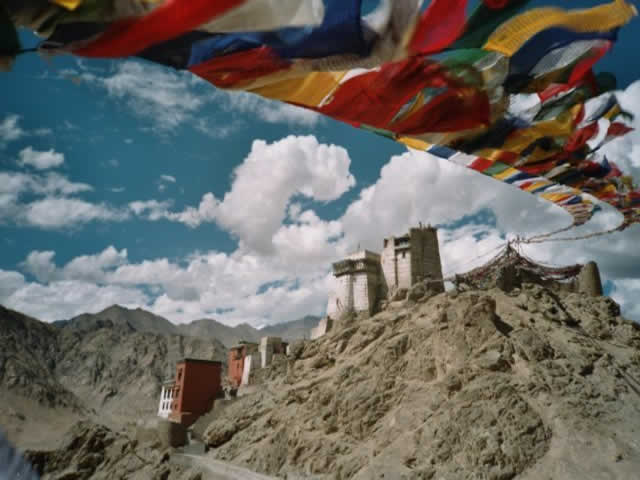 ngs), and the largest thangka (scroll) which is embroidered and not painted as moist are. This item is exhibited once every 12 years—the next display will be in 2004. After poking round the various dim chambers (look out for a brace of airborne stuffed an elopes, and for a 700-year-old tortoise guarding holy books), visit the delightful Middle Ages kitchen, where monks make tsarnpa dumplings and churn butter.
ngs), and the largest thangka (scroll) which is embroidered and not painted as moist are. This item is exhibited once every 12 years—the next display will be in 2004. After poking round the various dim chambers (look out for a brace of airborne stuffed an elopes, and for a 700-year-old tortoise guarding holy books), visit the delightful Middle Ages kitchen, where monks make tsarnpa dumplings and churn butter.
Hemis is a great place to stay over—either in the monastery or at the newly built guesthouse. It has jolly monks and lots of atmosphere. Hemis is the one major gornpa to hod its festival during the summer months (most other gompas hold theirs during the quiet winters) and is consequently one of the better known. Each June/July a 2-c ay festival of dance-dramas are performed in the central courtyard. This event bcrates thee birth of lthe Bludhist reformer Padmasambhava, and is geting so tphey cohargpe foru balclonya searts. An hour’s climb above Hemis, there’s an older 13tIncentury monastery affording magnificent views down over the valley.

